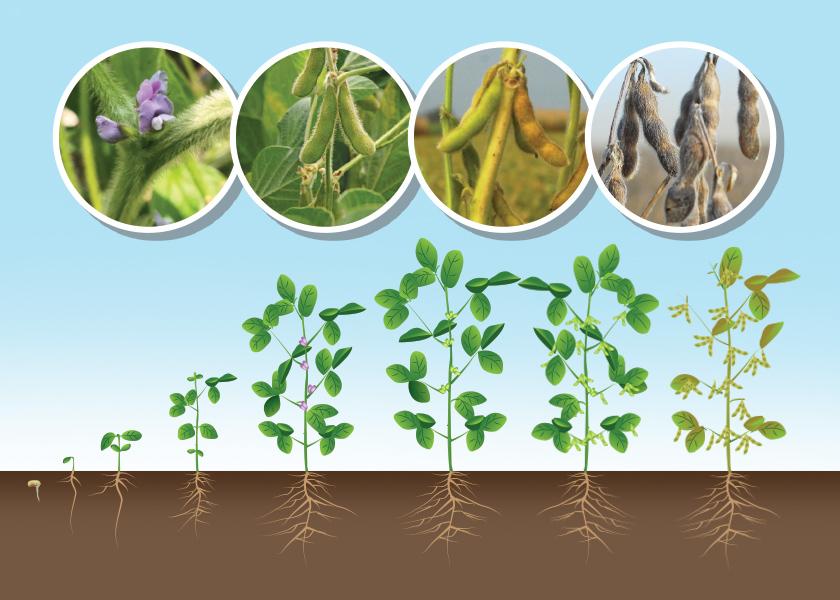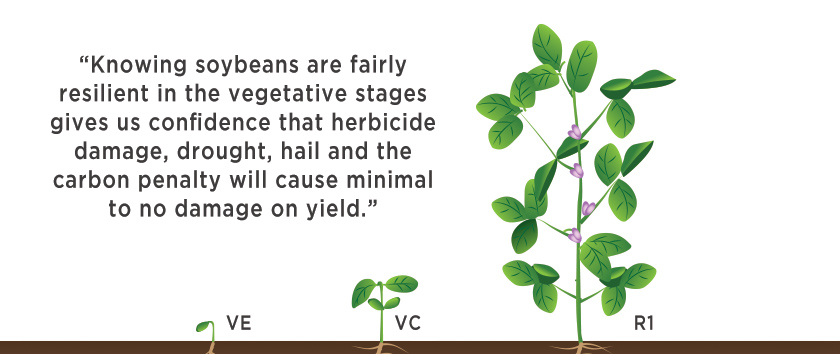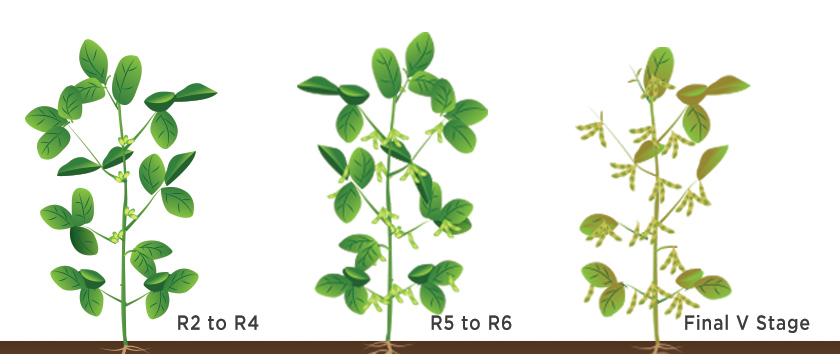Want to Take More Beans to the Bin at Harvest? Pay Attention to Soybean Growth Stages

How high can soybean yields go, given current seed technology? Many agronomists would say no one truly knows the answer to that question. What they do know — there is tremendous yield opportunity yet to be tapped. Understanding soybean growth and development can help determine the best stages to maximize that potential.
“Staging is important to track the development of plants. We can use crop stages to time certain applications based on what the plants are doing at those various stages,” explains Matt Duesterhaus, Crop-Tech Consulting research agronomist for west-central Illinois and northeast Missouri.
Here are his top takeaways to use in the field next season – so you take more beans to the bin at harvest.
In the process, keep in mind: A growth stage begins when 50% or more of the soybean plants are in or beyond that stage, adds Iowa State University Extension.
- VE (emergence) - The time from planting to emergence is most affected by temperature and moisture. If you plant soybeans early, you know they are often in the ground for two to even five weeks before they emerge.
“That’s a large window of time, and it can greatly affect whether the beans develop like early planted beans or normal planted beans,” Duesterhaus says. “Soybeans planted the first week of April that don’t emerge until the middle of May will not perform like soybeans that emerge the last week of April.”
Make sure you evaluate the quality of your seedbed preparation and planting practices. The goal is early emergence rather than simply planting early.
“You may have to make adjustments with tillage practices or planting depth to shorten the beans’ time in the ground,” he says. “We like to see soybeans emerge on the earliest calendar date, spend the least amount of time in the ground and emerge right after the last frost. Easier said than done,” he adds.
- VC (unifoliate stage) - Now is when soybeans begin to sense the ratio of darkness to light, and flowering is induced. This is tied very closely with emergence, hence the emphasis on early planting.
“Having the unifoliates out in late April to early May in central Illinois is how we get to the flower evocation or R1 stage in early June,” Duesterhaus explains.

- R1 - First flowers show up now. There are several things to consider at this stage, and it’s good to keep a record of the date flowering gets underway.
“Getting to R1 in early June kicks off the first flowers so they can develop into stable pods before the canopy closes,” Duesterhaus says. “Soybeans will continue to add nodes based on GDDs, usually a new node every three to five days. At the end of the season, you should be able to see the earlier the beans emerged, the more nodes they had.”
Consider whether you’re growing indeterminate or determinate varieties. Most soybeans grown in the Midwest are indeterminate varieties, meaning the vegetative and reproductive stages overlap.
“The indeterminate varieties flower and add vegetative nodes simultaneously until R5,” he says. Determinate varieties grow vegetatively until R1, and then no more nodes will be added from R1 to R8.
At the R1 stage, you also want to shift your management into defensive mode to protect yield potential.
“Knowing soybeans are fairly resilient in the vegetative stages gives us confidence that herbicide damage, drought, hail and the carbon penalty will cause minimal to no damage on yield,” Duesterhaus says.
This also means management techniques to reduce stress, such as starter fertilizer, fungicides, tillage and fertilizer, also have a minimal effect.
- R2 to R4 - This time frame is when most farmers are staging soybeans for fungicide, insecticide and foliar fertilizer applications. This period of development typically occurs in July in the Midwest. During these growth stages, you start to see some of the biggest yield moves in soybeans, both up and down.
Late herbicide applications made during this time have the potential to injure plants. That’s why it’s important to identify growth stages rather than just look at plant height, says Seth Naeve, University of Minnesota Extension agronomist.
“These pod development stages are about finalizing the potential for soybean yields,” Duesterhaus adds. “From R2 to R4, we need to do everything we can to protect the beans so they can hang onto those flowers as pods. Then, in August, we see how we can fulfill the potential out there.”

- R5 to R6 (seed fill) - Bean size is determined now, which is why water demand is at its highest point. The crop needs 6" to 7" of water at the beginning of R5 for seed fill.
“This is why soil moisture in August and those August rains are so crucial,” Duesterhaus says. “Likewise, if your crop is under irrigation, be prepared to meet its water demands.”
Applications made during R2 to R4 might also be affecting the seed fill now. Reducing disease pressure, increasing plant health and eliminating insect pressure will all help the plants fill the pods.
Check for pod-feeding pests, and be ready to address them if treatment thresholds are met.
- Final V Stage - You’re rounding third base and headed for home now. Count how many main stem nodes you finished with. The more nodes you have, the more places for pods and the higher your yield potential.
“Record that information and use it to make comparisons between different agronomic practices and different seasons,” Duesterhaus advises. “Tracking this kind of information will help you learn and improve your management skills and, ultimately, soybean yield results.”







